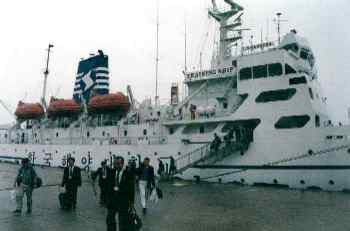
First Concrete Ceremony |
Back |
After excavation and pouring of substructure (fill) concrete, the pour of the first structural concrete symbolizes the beginning of the actual construction. A ceremony was held for this event in August, 2002. The trick was to get the VIPs there for the event. Travel to the site is not simple. Coming through Pyongyang is quite complex because, from Seoul, you must travel through Beijing. Also, since a large number of guests and news people were invited, there were no facilities on site to stay overnight. The solution was to take a ship. This is a training ship for the South Korean merchant marine. We were able to get on the the ship after clearing customs at Sinpo port in the evening. The group on the ship included representatives of the companies involved in the project, officials and ambassadors from the involved countries, and news people from organizations like the CBS, BBC, NHK, CNN, New York Times, etc. It's quite a contrast. The diplomatic people are always "on", making connections and keeping up the image. In contrast, the media people are, well, "casual".
The ship then traveled overnight to the Kumho site. It was a slow trip since the ship was not allowed to enter the DPRK territory after dark and, in fact, not allowed to use the radar system near the North Korean shore. This photo shows our ship at the rear and the smaller high speed boat that makes the trip back and forth to the site several times a week. The high powered double hull ship can make the trip in a few hours but it has a maximum capacity of about 100 people and some cargo. As we neared the site, we were met by a tugboat with North Korean authorities who inspected the ship. Their rusty tug looked like it was on it's last legs. We were taken into the harbor by the project tugboat which was provided from South Korea. There were also many fishing boats, checking us out with curiousity but being careful not to come to close.
At the site, we waited on the boat to get buses arranged to take us a short distance to "immigration". Although we left South Korea on our passports, we entered the site on special "KEDO passports". The first thing you notice entering the DPRK is that there are military personnel everywhere. DPRK has compulsory military service for all men. The duration of service varies from 5 to 10 years. The physical size of the soldiers was a bit of a surprise. Due to nutrition differences, North Koreans are somewhat shorter than South Koreans. However, at places like the DMZ, both sides try to assign the most physically imposing soldiers in visible posts. When we arrived at the site my first reaction, from a distance, was that they had female soldiers. Closer up, many of the soldiers looked like they belonged in high school - early years of high school.